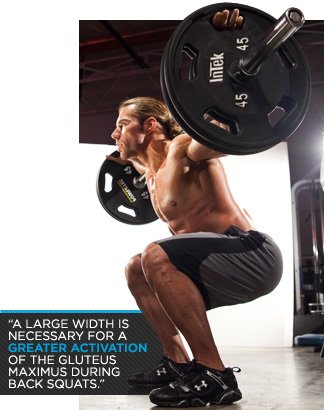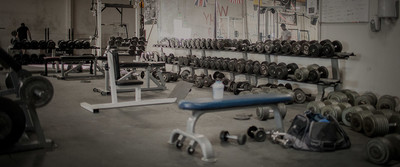Squats are a staple of any sound weightlifting program. Whether goblet, front, or back squats, the value of this classic exercise is undoubted, not only in terms of quadriceps growth but also functional capacity in life. That's why what I'm about to say might sound like blasphemy: It's time to rethink the way we squat.
Most squats you see in gyms today are performed with the feet planted at shoulder-width or narrower. These types of squats give a good burn to the quadriceps, and some people use varying narrow stances to target specific areas on the quads. But squats are a movement, not a specific muscle developer. The entire body should be activated in the lift, and especially the posterior chain and core.
Taking a wider stance than shoulder-width has been shown to provide the same level of quad activation as a traditional "narrow" stance, but squatting wide also provides distinct advantages.
A wide stance works a greater number of muscles. Go wide, and you'll feel it in your glutes, your overall strength, and maybe in the back and knee pain you don't feel.
Go Wide, Young Man
Perhaps a better question to ask is "Why go narrow?" It could be argued that the narrow squat better mimics life applications, but the goal with a wide stance is muscular development and strength. There's always room in life for more strength.
If you decide to step out, you will notice the benefits:
1. Glute Activation

{{caption}}
If you want to think of squats as "developing" a certain muscle, it's better to think of the glutes than the quads.
The glutes are a tremendous source of power and strength, and if you can use their strength in a movement, you almost always should.
Take a wider stance when squatting, such as 140-150 percent of shoulder width. This allows for greater posterior displacement of the hips.
This displacement activates the glutes to a greater degree than narrow squats when depth is reached, according to research from the University of Abertay, in Dundee, Scotland.
A study at the University of Padova in Italy took the conclusion a step further, suggesting that "a large width is necessary for a greater activation of the gluteus maximus during back squats."
2. Quadriceps Activation
Much of the popularity for narrow-stance squats is based on personal opinion and "feel." This is understandable. We train because we enjoy the challenge and the burn. We're taught that pain leads to success. A wider stance might not stimulate the same feeling on your quadriceps, but the activity is there.
The University of Padova study concluded that a wide stance produces the same muscular activation as a narrow stance in the quads, adductor major, vastus medialis and lateralis-everywhere but the glutes.
Make no mistake: Changing the stance changes the movement. Narrow stances require an anterior tracking of the knee, and while this is not inherently a bad movement, it does place a greater stress on the knee. Over time, the recessive forces exerted on the knee could lead to patellar tendon strains or tendonitis.
By comparison, reaching squat depth with a wide stance requires a lifter to maintain a more vertical shin position than a narrow stance. This stance places far less stress on the knee.
3. Ankle Mobility
The narrow range of motion of the human ankle can be a limiting factor when performing a narrow-stance squat. A wider stance alleviates this issue by maintaining a more vertical shin position, providing an easier trip to reach depth.
Of course you could and should address your tight calves and lower legs with mobility drills and foam rolling, but there's no reason you should limit your squatting pattern just because you can't reach depth in a narrow stance. Bump those feet out!
4 Power Production
Power is what we're after, right? It is the heart of athletics, and no matter the activity, powerful players perform well. By activating more muscle fiber, and different muscle groups, wide squats provide a clear advantage for hypertrophic gains which can transfer to competitive athletics.
Wide squats are also more powerful, period. A recent study published in the Journal of Strength & Conditioning found that the squat power produced at 150 percent of shoulder-width was "significantly higher" than at 50 percent width, 100 percent, or at 200 percent.
This raises an important point: Some argue that ultra-wide stances such as 200 percent have value in geared lifting, but they are not generally thought to be best for power development.
It's All in the Hips
Hip strength and function have recently been getting much-needed attention in strength and conditioning programs. More trainers are emphasizing movements rather than muscles in an all-encompassing approach to training.
This is a fantastic way to combat the quad dominance and glute weakness that plague sedentary populations. Wide squats allow for more comprehensive movement that better works the hips than traditional squats.
The hips are multidirectional joints, producing force in three planes of motion. The wide-stance squat provides the best option to train the hips in all three planes. The wide movement exhibits greater hip flexion and smaller plantarflexion angles than narrow-stance squats. It also produces significantly larger hip extension movements.
Wide-stance squats are achieved with a posterior tracking of the hips, which leads to greater hip extension to return the bar to the original position. Wide squats have been shown to produce greater abduction and adduction, with greater internal and external rotation of the femur during the lift than narrow squats.
Spreading movement across all three planes of motion helps to create a stable hip joint that can handle a tremendous amount of stress, not only in the gym but also in life.
Save Your Spine
Some argue that the horizontal positioning of the torso during a wide stance squat creates larger loads on the lumbar, as compared to a narrow stance. This is believed to increase the risk for low-back injuries. Recent studies do not support this conclusion.
When performing a narrow squat, the distance to parallel is greater than in a wide squat. Reaching depth in a narrow squat requires tucking the lumbar under the torso to facilitate hip flexion. The resulting flexion of the spine under a load puts pressure on the L5/S1 area, which could be linked to bulging discs and other spinal complications.
This is not to say that a traditional squat will cause low-back injury, but without consistent development in this squatting pattern, the greater force placed on the spine can take a toll over time. The posterior movement of the hips in a wide stance can contribute to a more neutral back positioning without tucking your lumbar.
A wider stance also recruits more muscles to perform the task, and is a more encompassing movement compared to a narrow stance. The goal of any compound lift should be engaging as many muscles as possible, and it is clear that a wider stance better accomplishes this task.

